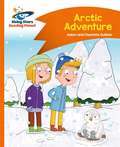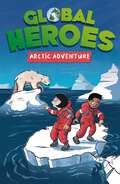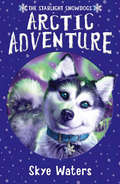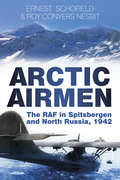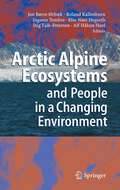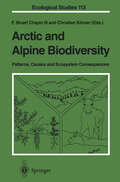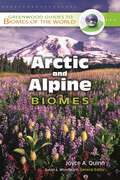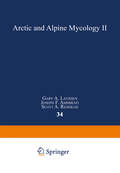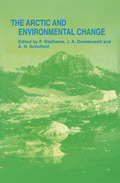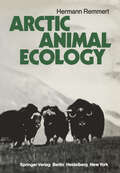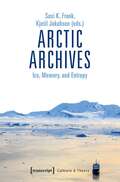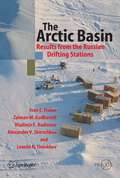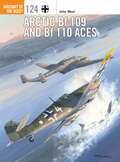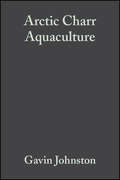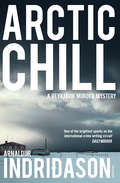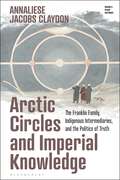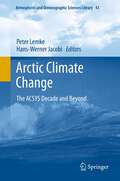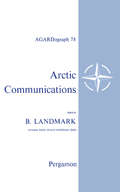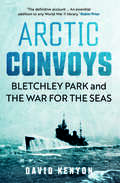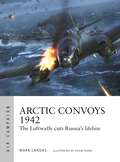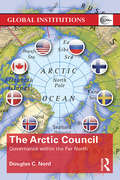- Table View
- List View
Arctic Adventure (Rising Stars Reading Planet Ser.)
by Helen ChapmanSome little owl chicks have just hatched at the wildlife park! When Tess and Finn go to see them, they're swept away to meet some snowy owl chicks – in the Arctic! The owls are hungry and cold, because their mother is missing! Can Finn and Tess find the mother snowy owl? Arctic Adventure is part of the Comet Street Kids range of books from Rising Stars Reading Planet. Comet Street Kids is an action-packed character series with highly decodable books for Pink A to White band. Children will love experiencing the amazing adventures of Rav, Asha, Tess, Finn and Stefan! Reading Planet books have been carefully levelled to support children in becoming fluent and confident readers. Each book features useful notes and activities to support reading at home as well as comprehension questions to check understanding. Reading age: 5-6 years
Arctic Adventure (Global Heroes #4)
by Damian HarveyJoin our team of Global Heroes in this fast-paced, science-themed chapter book set in the abominably cold arctic!Great for readers age 7+ these adventure stories are also full of fascinating facts. These illustrated chapter books are perfect for making fascinating science topics accessible to young readers, inspiring a thirst for knowledge and learning by stealth. The team of characters come from around the world to give a truly global outlook.
Arctic Adventure (Starlight Snowdogs #2)
by Skye WatersJoin Ella and her husky puppy on magical adventures with the Starlight Snow Dogs!
Arctic Airmen: The RAF in Spitsbergen and North Russia, 1942
by Ernest Schofield Roy Conyers NesbitIn 1942 a Catalina crew of 210 Squadron, based at Sullom Voe in the Shetlands, was selected to carry out a series of highly secret operations, including a flight to the North Pole. The sorties were associated with a Norwegian expedition from Britain to Spitsbergen, to deny the use of the territory to the enemy. The flights made by the crew were frequently over twenty-four hours in length and reached the limits of human endurance, in conditions of extreme cold. Later, the squadron was detached to North Russia, to provide cover for the convoys taking vital supplies to the Allies on the Eastern Front. The navigator of the crew, Ernest Schofield, retained logs of most of these sorties. Together with other survivors of the crew, accounts from German sources and research carried out by Roy Conyers Nesbit, he recreated these little-known events, in detailed and accurate narrative that ends in tragedy.
Arctic Alpine Ecosystems and People in a Changing Environment
by Ingunn Tombre Else N. Hegseth Stig Falk-Petersen Alf H. Hoel Jon Børre Ørbaek Roland KallenbornThe European Arctic and Alpine regions are experiencing large environmental changes. These changes may have socio-economic effects if the changes affect the bioproduction, which form the basis for the marine and terrestrial food chains. This uniquely multidisciplinary book presents the various aspects of contemporary environmental changes in Arctic and Alpine Regions.
Arctic and Alpine Biodiversity: Patterns, Causes and Ecosystem Consequences (Ecological Studies #113)
by F. Stuart Iii Chapin Christian KörnerAs human populations expand and have increasing access to technol ogy, two general environmental concerns have arisen. First, human pop ulations are having increasing impact on the earth system, such that we are altering the biospheric carbon pools, basic processes of elemental cycling and the climate system of the earth. Because of time lags and feedbacks, these processes are not easily reversed. These alterations are occurring now more rapidly than at any time in the last several million years. Secondly, human activities are causing changes in the earth's biota that lead to species extinctions at a rate and magnitude rivaling those of past geologic extinction events. Although environmental change is potentially reversible at some time scales, the loss of species is irrevo cable. Changes in diversity at other scales are also cause for concern. Habitat fragmentation and declines in population sizes alter genetic di versity. Loss or introduction of new functional groups, such as nitro gen fixers or rodents onto islands can strongly alter ecosystem processes. Changes in landscape diversity through habitat modification and frag mentation alter the nature of processes within and among vegetation patches. Although both ecological changes altering the earth system and the loss of biotic diversity have been major sources of concern in recent years, these concerns have been largely independent, with little concern for the environmental causes the ecosystem consequences of changes in biodiversity. These two processes are clearly interrelated. Changes in ecological systems cause changes in diversity.
Arctic and Alpine Biomes (Greenwood Guides to Biomes of the World)
by Joyce A. QuinnThis volume in the Greenwood Guides to Biomes of the World: series covers the biomes at high altitudes and near the poles, including the arctic tundra biomes, the Mid-Latitude Alpine Tundra Biome (found in the mountain ranges of North America, Asia, and South America), and the tropical alpine tundra biome (for example, Hawaii).
Arctic and Alpine Mycology II (Environmental Science Research #34)
by Gary A. Laursen Joseph F. Ammirati Scott A. RedheadDuring the summer of 1980, the First International symposium on Arctic and Alpine Mycology (ISAM-I) was held at the then extant Naval Arctic Research Laboratory near Barrow, Alaska, U.S.A., well within the Arctic Circle (Laursen and Ammirati, Arctic and Alpine Mycology. The First International symposium on Arcto-Alpine Mycology. Univ. Wash. Press, 1982). The facility is currently owned and operated by the Utkeagvik Inupiat community and is named the National Academic and Research Laboratory, thus retaining its acronym NARL. Twenty-five scientists participated in that historic first meeting. Their interests in the fungi spanned a vast geographic area of cold dominated habitats in both the northern and southern hemispheres that included four continents (N. and S. America, Eurasia,and Antarctica), nine countries, and numerous islands ranging from Greenland to Jan Mayen in the Svalbard group. ISAM-I helped to develop ongoing interests and initiate others. This is what ISAM-I founders hoped would happen. Asa result, the organizing committee for ISAM-II was formed. Its mandate was to: involve a maximum of one third new participants in future ISAM meetings: divide the responsibility for organizing future meetings at sites located in areas of interest to research thrusts in Arctic and alpine environments: keep the number of participants small enough to ensure manageability, taking full advantage of field collecting opportunities with minimal complications and cost.
Arctic and Environmental Change
by J. A. DowdeswellThis timely book presents a wide-ranging review of Arctic environmental change in response to global warming, and gives a broad insight into the transformation of the Arctic which we can expect during the next century. It is in high northern latitudes that we can expect to observe global warming at its most powerful, making it a natural laboratory where climate changes and their impacts can be monitored and studied more readily than elsewhere in the world. Fourteen authoritative reviews cover the predictions of warming rates by General Circulation Models; variabilities in atmospheric circulation and moisture flux; the dynamics of the polar vortex in the Arctic and its role in ozone loss; the countervailing influence of air pollution in reducing solar irradiance; and the impact of climatic change on Arctic terrestrial and marine ecosystems. Also detailed are the thermohaline circulation of the ocean, the extent and thickness of sea ice, the sizes of glaciers and ice sheets, and the extent of permafrost. Moving to past changes, the records from Greenland ice cores and deep ocean drilling are reviewed for what they tell us about past climates and glaciation in the Arctic., The book paints a vivid and disturbing picture of the enhanced warming that can be expected in the Arctic relative to lower latitudes, and of the major impacts that this will have on the northern cryosphere. It will be an invaluable reference for anyone seeking a greater understanding of the factors and processes affecting the arctic environment, which may ultimately have a major impact on global climatic change.
Arctic and Environmental Change
by J. A. DowdeswellThis timely book presents a wide-ranging review of Arctic environmental change in response to global warming, and gives a broad insight into the transformation of the Arctic which we can expect during the next century. It is in high northern latitudes that we can expect to observe global warming at its most powerful, making it a natural laboratory where climate changes and their impacts can be monitored and studied more readily than elsewhere in the world. Fourteen authoritative reviews cover the predictions of warming rates by General Circulation Models; variabilities in atmospheric circulation and moisture flux; the dynamics of the polar vortex in the Arctic and its role in ozone loss; the countervailing influence of air pollution in reducing solar irradiance; and the impact of climatic change on Arctic terrestrial and marine ecosystems. Also detailed are the thermohaline circulation of the ocean, the extent and thickness of sea ice, the sizes of glaciers and ice sheets, and the extent of permafrost. Moving to past changes, the records from Greenland ice cores and deep ocean drilling are reviewed for what they tell us about past climates and glaciation in the Arctic., The book paints a vivid and disturbing picture of the enhanced warming that can be expected in the Arctic relative to lower latitudes, and of the major impacts that this will have on the northern cryosphere. It will be an invaluable reference for anyone seeking a greater understanding of the factors and processes affecting the arctic environment, which may ultimately have a major impact on global climatic change.
Arctic Animal Ecology
by Hermann RemmertA large number of comprehensive publications has been devoted to the Antarctic, to its plant and animal life. It is therefore relatively easy to familiarize oneself with the current state of Antarctic research. Nothing comparable is available for the Arctic. The heterogeneity and richness of the northern polar regions seem to have discouraged any attempt at a synthethic approach. This book has evolved from an attempt to summarize the results of 15 years of ecological and physiological research work in the Arctic - mostly on Spitsbergen. The necessity of comparing our results and the ecological conditions of Spitsbergen with other arctic regions grew into a full-sized book on arctic animal ecology. It is not meant as an exhaustive survey ofthe relevant literature. Instead I have tried to show how closely the various fields of research are interwoven, how many questions can be solved if only notice is taken of fellow scientists and their results, and how much arctic animals have in common. This book would not have been possible without the helpfulness of many colleagues. Above all I should like to mention Professor Ronning and Professor Solem of Trondheim University (Norway), Professor Arnthor Gardasson of Reykjavik University (Iceland), Dr. NettIeship, Dr. Oliver and Dr. Ryder of Canada and Professor West of Fairbanks University (Alaska, USA).
Arctic Archives: Ice, Memory and Entropy (Edition Kulturwissenschaft #194)
by Susi K. Frank Kjetil A. JakobsenThis pioneering volume explores the Arctic as an important and highly endangered archive of knowledge about natural as well as human history of the anthropocene. Focusing on the Arctic as an archive means to investigate it not only as a place of human history and memory - of Arctic exploring, ›conquering‹ and colonizing -, but to take into account also the specific environmental conditions of the circumpolar region: ice and permafrost. These have allowed a huge natural archive to emerge, offering rich sources for natural scientists and historians alike. Examining the debate on the notion of (›natural‹) archive, the cultural semantics and historicity of the meaning of concepts like ›warm‹, ›cold‹, ›freezing‹ and ›melting‹ as well as various works of literature, art and science on Arctic topics, this volume brings together literary scholars, historians of knowledge and philosophy, art historians, media theorists and archivologists.
The Arctic Basin: Results from the Russian Drifting Stations (Springer Praxis Books)
by Ivan E. Frolov Zalman M. Gudkovich Vladimir F. Radionov Alexander V. Shirochkov Leonid A. TimokhovArctic Bf 109 and Bf 110 Aces (Aircraft of the Aces #124)
by John WealOnce Nazi Germany had conquered Norway in 1940, just a handful of Gruppen flying the Bf 109 and Bf 110 fighters were able to shatter all opposition and dominate the air in the Arctic Circle. Yet as the dual threats of the RAF and the Red Air Force grew, the Luftwaffe was forced to increase its fighter presence to full Geschwader strength with the formation of JG 5 Eismeer (Ice-sea) in early 1942.The struggle for the frozen skies of the arctic raged on until the end of the war as the embattled JG 5 produced some of the Eastern Front's leading aces, pilots of the calibre of Theodor Weissenberger, Heinrich Ehrler, Walter Schuck, Franz Dörr and Jakob Norz all achieving over 100 kills. Featuring first-hand accounts from the pilots, extensive research from a leading authority on the Luftwaffe, and illustrations of the aircraft in unique winter camouflage, this book is a comprehensive guide to the Arctic Experten and the planes they flew.
Arctic Bf 109 and Bf 110 Aces (Aircraft of the Aces)
by John Weal Chris Davey Mark PostlethwaiteOnce Nazi Germany had conquered Norway in 1940, just a handful of Gruppen flying the Bf 109 and Bf 110 fighters were able to shatter all opposition and dominate the air in the Arctic Circle. Yet as the dual threats of the RAF and the Red Air Force grew, the Luftwaffe was forced to increase its fighter presence to full Geschwader strength with the formation of JG 5 Eismeer (Ice-sea) in early 1942.The struggle for the frozen skies of the arctic raged on until the end of the war as the embattled JG 5 produced some of the Eastern Front's leading aces, pilots of the calibre of Theodor Weissenberger, Heinrich Ehrler, Walter Schuck, Franz Dörr and Jakob Norz all achieving over 100 kills. Featuring first-hand accounts from the pilots, extensive research from a leading authority on the Luftwaffe, and illustrations of the aircraft in unique winter camouflage, this book is a comprehensive guide to the Arctic Experten and the planes they flew.
Arctic Charr Aquaculture
by Gavin JohnstonThis important book draws together, for the first time, a vast wealth of information on all major aspects of the farming of Arctic charr, a highly prized and commercially valuable salmonid. The author, Gavin Johnston who has many years' experience of farming Arctic charr, teaching about and researching the species, has produced a book that is a landmark publication and an essential purchase for all those involved with the species. The book is broadly divided into three sections. The first section covers Arctic charr interactions with humans and the charr's biological requirements for culture. Section two is a practical guide to the art and science of early-rearing Arctic charr; a hands on application of current knowledge in Arctic charr aquaculture. The final section of the book focuses on the commercial production of Arctic charr, providing cutting-edge information for all those involved in the exploitation of this valuable species. Arctic Charr Aquaculture is an essential purchase for anyone involved in, or considering involvement in farming of this species. Farm managers and other personnel in fish farms and experimental aquaculture units, fish and aquatic biologists will find a huge amount of useful data in this book. Libraries in all university departments and research establishments where aquaculture, fisheries and fish biology are studies and taught should have copies of this book on their shelves. This book brings together for the first time the knowledge needed to farm and market Arctic Charr. Part One is an overview of Arctic Charr aquaculture beginning with the history and development of Charr aquaculture, the biological attributes of Arctic Charr, the physical requirements for growth and commercial production requirements. Other chapters are devoted to Charr health, nutrition and feeding. Part Two is a practical guide for the producer operating an Arctic Charr farm either as a vertically integrated operation or as discrete hatcheries and grow out farms. Part Three is devoted to the business of commercially producing Arctic Charr, and although it deals specifically with Charr it also covers many business aspects of farming relevant to any fish species under cold water cultivation. It covers farm business management, the economics and finance of Arctic Charr farming, marketing Charr products and a closing section on how to avoid the pitfalls which others including the author have experienced.
Arctic Chill (Inspector Erlendur Ser.)
by Arnaldur Indridason Bernard Scudder Victoria CribbA dark-skinned young boy is found dead, frozen to the ground in a pool of his own blood. The boy's Thai half-brother is missing; is he implicated, or simply afraid for his own life? While fears increase that the murder could have been racially motivated, the police receive reports that a suspected paedophile has been spotted in the area.Detective Erlendur's investigation soon unearths the tension simmering beneath the surface of Iceland's outwardly liberal, multi-cultural society while the murder forces Erlendur to confront the tragedy in his own past.
Arctic Circles and Imperial Knowledge: The Franklin Family, Indigenous Intermediaries, and the Politics of Truth (Empire’s Other Histories)
by Annaliese Jacobs ClaydonIn 1845 an expedition led by Sir John Franklin vanished in the Canadian Arctic. The enduring obsession with the Franklin mystery, and in particular Inuit information about its fate, is partly due to the ways in which information was circulated in these imperial spaces. This book examines how the Franklins and other explorer families engaged in science, exploration and the exchange of information in the early to mid-19th century. It follows the Franklins from the Arctic to Van Diemen's Land, charting how they worked with intermediaries, imperial humanitarians and scientists, and shows how they used these experiences to claim a moral right to information. Arctic Circles and Imperial Knowledge shows how the indigenous peoples, translators, fur traders, whalers, convicts and sailors who explorer families relied upon for information were both indispensable and inconvenient to the Franklins. It reveals a deep entanglement of polar expedition with British imperialism, and shows how geographical knowledge intertwined with convict policy, humanitarianism, genocide and authority. In these imperial spaces families such as the Franklins negotiated their tenuous authority over knowledge to engage with the politics of truth and question the credibility and trustworthiness of those they sought to silence.
Arctic Circles and Imperial Knowledge: The Franklin Family, Indigenous Intermediaries, and the Politics of Truth (Empire’s Other Histories)
by Annaliese Jacobs ClaydonIn 1845 an expedition led by Sir John Franklin vanished in the Canadian Arctic. The enduring obsession with the Franklin mystery, and in particular Inuit information about its fate, is partly due to the ways in which information was circulated in these imperial spaces. This book examines how the Franklins and other explorer families engaged in science, exploration and the exchange of information in the early to mid-19th century. It follows the Franklins from the Arctic to Van Diemen's Land, charting how they worked with intermediaries, imperial humanitarians and scientists, and shows how they used these experiences to claim a moral right to information. Arctic Circles and Imperial Knowledge shows how the indigenous peoples, translators, fur traders, whalers, convicts and sailors who explorer families relied upon for information were both indispensable and inconvenient to the Franklins. It reveals a deep entanglement of polar expedition with British imperialism, and shows how geographical knowledge intertwined with convict policy, humanitarianism, genocide and authority. In these imperial spaces families such as the Franklins negotiated their tenuous authority over knowledge to engage with the politics of truth and question the credibility and trustworthiness of those they sought to silence.
Arctic Climate Change: The ACSYS Decade and Beyond (Atmospheric and Oceanographic Sciences Library #43)
by Peter Lemke and Hans-Werner JacobiThe Arctic is now experiencing some of the most rapid and severe climate change on earth. Over the next 100 years, climate change is expected to accelerate, contributing to major physical, ecological, social, and economic changes, many of which have already begun. Changes in arctic climate will also affect the rest of the world through increased global warming and rising sea levels.The volume addresses the following major topics:- Research results in observing aspects of the Arctic climate system and its processes across a range of time and space scales- Representation of cryospheric, atmospheric, and oceanic processes in models, including simulation of their interaction with coupled models - Our understanding of the role of the Arctic in the global climate system, its response to large-scale climate variations, and the processes involved.
Arctic Communications: Proceedings of the Eighth Meeting of the AGARD Ionospheric Research Committee, Athens, Greece, July 1963
by B. LandmarkArctic Communications is a compilation of the proceedings of the Eighth Meeting of the Ionospheric Research Committee of NATO's Advisory Group for Aeronautical Research and Development, held in Athens, Greece in July 1963. The meeting provided a forum for discussing advances in communications equipment used to conduct research in the Arctic and covered a wide range of topics such as the physical properties of the Arctic ionosphere; Arctic high-frequency communications; soundings and field strength measurements; and observations in the Arctic during nuclear tests. This book is comprised of 25 chapters and begins with a discussion on experimental studies of high latitude absorption phenomena, including auroral absorption, polar cap absorption, and sudden commencement absorption. Direct measurements of D-region electron densities during the absorption periods are also presented. Subsequent chapters focus on the ionospheric absorption of cosmic noise observed at geomagnetically conjugate points; ionospheric ionization produced by solar flares; military communication facilities in the Canadian Arctic; and radio noise problems in Arctic regions. Phase instabilities on a very-low-frequency transmission path passing through the auroral zone are also considered. This monograph will be of particular value to scientists and researchers with interest in the Arctic.
Arctic Convoys: Bletchley Park and the War for the Seas
by David KenyonAn incisive account of the Arctic convoys, and the essential role Bletchley Park and Special Intelligence played in Allied success Between 1941 and 1945, more than eight hundred shiploads of supplies were delivered to the Soviet Union protected by allied naval forces. Each journey was a battle against the elements, with turbulent seas, extreme cold, and the constant dread of torpedoes. These Arctic convoys have been mythologized as defenseless vessels at the mercy of deadly U-boats—but was this really the case? David Kenyon explores the story of the war in the Arctic, revealing that the contest was more evenly balanced that previously thought. Battles included major ship engagements, aircraft carriers, and combat between surface ships. Amid this wide range of forces, Bletchley Park’s Naval Section played a decisive role in Arctic operations, with both sides relying heavily on Signals Intelligence to intercept and break each other’s codes. Kenyon presents a vivid picture of the Arctic theater of war, unearthing the full-scale campaign for naval supremacy in northern waters.
Arctic Convoys 1942: The Luftwaffe cuts Russia's lifeline (Air Campaign)
by Mark LardasA new history of the most crucial few months of the Arctic Convoys, when Germany's air power forced the Allies to retreat to the cover of winter. Between spring and autumn 1942, Germany was winning the battle of the Arctic Convoys. Half of PQ-15 was sunk in May, PQ-17 was virtually obliterated in July, and in September 30 percent of PQ-18 was sunk. The Allies were forced to suspend the convoys until December, when the long Arctic nights would shield them.Mark Lardas argues that in 1942, it was Luftwaffe air power that made the difference. With convoys sailing in endless daylight, German strike aircraft now equipped and trained for torpedo attacks, and bases in northern Norway available, the Luftwaffe could wreak havoc. Three-quarters of the losses of PQ-18 were due to air attacks. But in November, the Luftwaffe was redeployed south to challenge the Allied landings in North Africa, and the advantage was lost. Despite that, the Allies never again sailed an Arctic convoy in the summer months.Fully illustrated with archive photos, striking new artwork, maps and diagrams, this is the remarkable history of the Luftwaffe's last strategic victory of World War II.
Arctic Convoys 1942: The Luftwaffe cuts Russia's lifeline (Air Campaign)
by Mark LardasA new history of the most crucial few months of the Arctic Convoys, when Germany's air power forced the Allies to retreat to the cover of winter. Between spring and autumn 1942, Germany was winning the battle of the Arctic Convoys. Half of PQ-15 was sunk in May, PQ-17 was virtually obliterated in July, and in September 30 percent of PQ-18 was sunk. The Allies were forced to suspend the convoys until December, when the long Arctic nights would shield them.Mark Lardas argues that in 1942, it was Luftwaffe air power that made the difference. With convoys sailing in endless daylight, German strike aircraft now equipped and trained for torpedo attacks, and bases in northern Norway available, the Luftwaffe could wreak havoc. Three-quarters of the losses of PQ-18 were due to air attacks. But in November, the Luftwaffe was redeployed south to challenge the Allied landings in North Africa, and the advantage was lost. Despite that, the Allies never again sailed an Arctic convoy in the summer months.Fully illustrated with archive photos, striking new artwork, maps and diagrams, this is the remarkable history of the Luftwaffe's last strategic victory of World War II.
The Arctic Council: Governance within the Far North (Global Institutions)
by Douglas C. NordThis book helps us to think carefully about how this area of the world should be best handled in the future by offering a concise and accessible introduction to the Arctic Council. Over the past two decades, the Arctic has evolved from being a remote region in international affairs to becoming an increasingly central concern of the global community. The issues of climate change, access to new energy resources, the development of new global trade routes, the protection of the natural environment and the preservation of indigenous cultures and languages have all come to be focused within this formerly neglected region. Now in its nineteenth year of operation the Arctic Council, an innovative international organization, is going through a period of new growth and challenges. This work identifies the major trends and directions of current Arctic diplomacy and the manner in which national, regional and international leaders and organizations can all make useful contributions in dealing with the complex agenda of environmental, economic and political challenges faced by this increasingly significant area of the globe. This book will be of great interest to students and scholars of international organizations, international relations and the environment.
